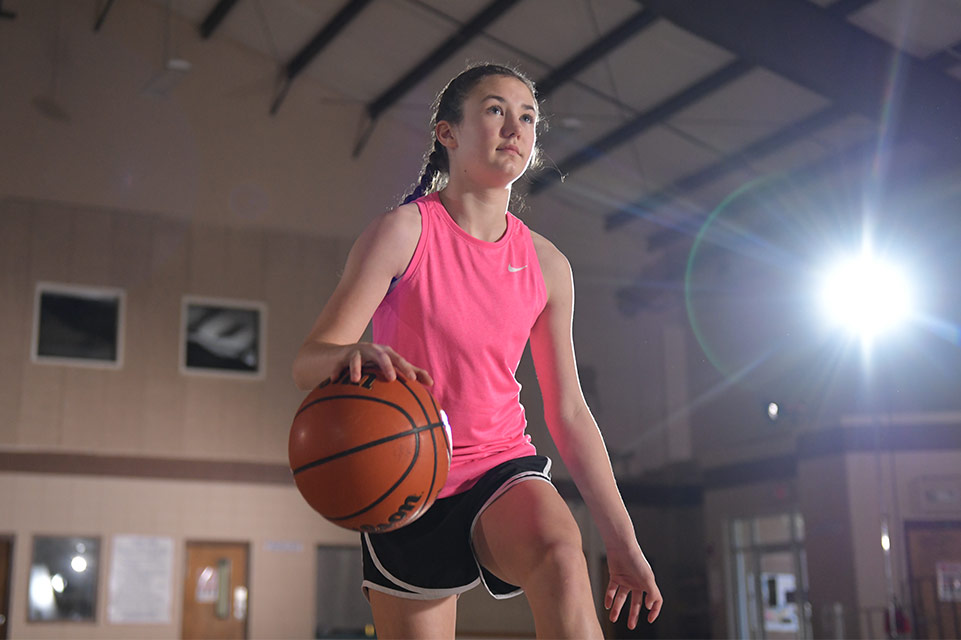Bridget’s Story: An Athlete’s Triumphant Return to the Stage
Fifteen-year-old Bridget has been dancing for almost as long as she has been walking.
Her mother, Erin, signed her up for dance classes when she was 2, and her love for dance was immediately evident. When she was 6, she auditioned for – and made – the competition dance team. When she was 12, Bridget was dancing five days a week on four different competitive teams.
One day, Bridget was perfecting a front aerial – an advanced acrobatic front flip move – something she had done hundreds of times before. But this time was different. “As I headed down the mat, I slipped and felt something very wrong with my knee,” said Bridget. “I was in immediate pain. I couldn’t put any weight on my knee. I think I was in denial that I was hurt, though, because I had never had an injury like that before.”
“In that moment, everything in Bridget’s world stopped,” said Erin. "We knew she wouldn’t be dancing for a while, which was crushing.”
Following a visit to the emergency room, Bridget’s primary care doctor referred her to the sports medicine team at Shriners Children’s New England. “Walking in the door, we were very worried that the doctor wouldn’t understand that dancers are athletes,” said Erin. “But, from our first meeting and throughout Bridget’s treatment, the entire team treated her like an elite athlete.”
“I have been misunderstood as an athlete before,” said Bridget. “I was relieved to find a team that recognized and respected my commitment to a very demanding sport.”
A complete evaluation, including an MRI, confirmed that Bridget had experienced a first-time kneecap dislocation without other injuries to the knee. Orthopedic surgeon Ahmad F. Bayomy, M.D., diagnosed her with patellofemoral instability. “We understood that Bridget was passionate about returning to a high level of dance as soon as possible," said Dr. Bayomy. “After reviewing the options and considerations specific to Bridget, we agreed that she was a terrific candidate to try the non-surgical route.”
Bridget was fitted for a knee brace in the prosthetics and orthotics department and began eight weeks of physical therapy with physical therapist Erin Milano, PT, D.P.T., who was also a trained dancer. “We try to pair patients with therapists who are familiar with the patient’s sport. I knew Erin’s background as a performing arts athlete would help maximize Bridget’s time spent in treatment,” said Dr. Bayomy.
That autumn, Bridget made a gradual return to her sport and performed at a high level throughout the winter months. Three months after her injury, she had her first competition and won first place. “In my mind, it was like the injury never happened,” she said.
This entire experience wouldn’t have been the same anywhere else. Bridget was treated as an athlete from day one and that made all the difference in her care.
The following spring, however, Bridget’s world collapsed once again. She experienced a second kneecap dislocation while performing the same front aerial move.
“We knew after the first injury that this was a possibility. That even after physical therapy and all the hard work she put in, this injury could be something that could continue as she performs,” said her mother.
“I was devastated and thought I would never dance again,” said Bridget.
“We reviewed treatment options again, now noting that Bridget’s risk for continued dislocations was thought to be much higher, along with significant impacts on her quality of life and ability to dance,” said Dr. Bayomy. “The consensus was to proceed with growth plate-sparing surgery to stabilize the kneecap.”
After a successful medial patellofemoral ligament reconstruction with Dr. Bayomy, Bridget was ready to start physical therapy. She was once again paired with physical therapist Erin Milano. Understanding Bridget’s goals and skill level, Erin again incorporated dance into a personalized program for Bridget, re-envisioning exercises to fit her needs.
“Erin had been in my shoes growing up, being a competition dancer and loving the sport just as much as I did,” said Bridget. "During my physical therapy sessions, I would bring my ballet shoes and work on simple ballet steps at first. As I got stronger and neared the end of my therapy, I was leaping, turning and doing tricks in the hallway!”
Six months after her surgery, Bridget was cleared to return to dance. Two months later, she was back on stage competing and winning.
“It has always been my dream to become a professional dancer,” said Bridget. “At times, these injuries made that dream seem like an impossibility, but now I am able to continue to pursue my passion. I am so grateful for Shriners. They will always have a special place in my heart.”
Her mother agrees. “This entire experience wouldn’t have been the same anywhere else. Bridget was treated as an athlete from day one and that made all the difference in her care. They worked together as a cohesive team to get her back to her top level of performance,” she said. “I can’t stress enough how important that was to us and to her future success.”

Despite her knee injury, Bridget continues to shine on stage.

